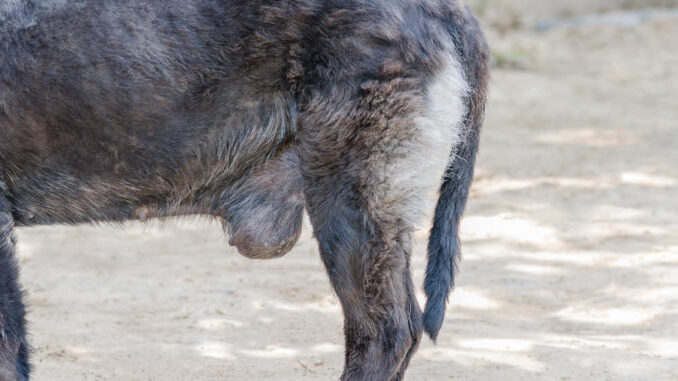
This article was updated on January 27th, 2024

Not only are dogs capable of developing breast or mammary cancer, but they also do so at an alarming rate, especially if they’re left intact. An intact female has a 23-34% chance of developing a mammary tumor during their lifetime. Those are not good odds. Fortunately, early detection and treatment will greatly improve her outcome.
This article will help you get familiar with what dog mammary tumors look like so that you can get a diagnosis and treatment early on for the best possible outcome. We’ll also dive into treatments and prognosis.
What mammary tumors look like in dogs (with pictures)
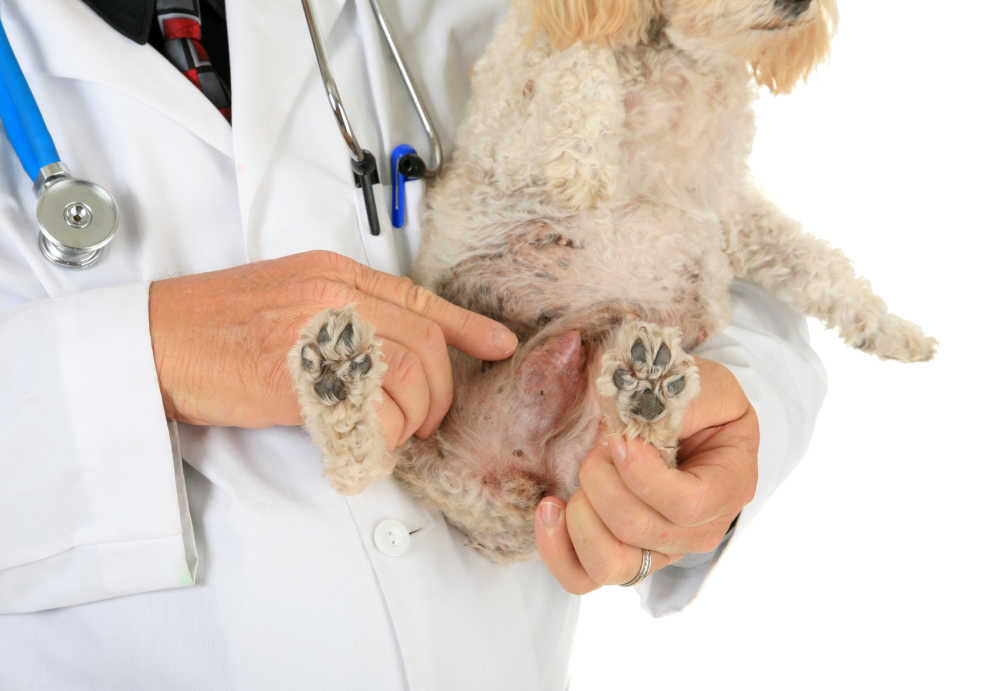
Dog mammary tumors are lumps that come from the mammary tissue along a dog’s belly. Most female dogs have five sets of mammary glands that extend from the groin to their armpits. Dogs can develop tumors in one or more glands or in the entire mammary chain on one side.
[Warning – some of the images featured below may be considered graphic by some readers]
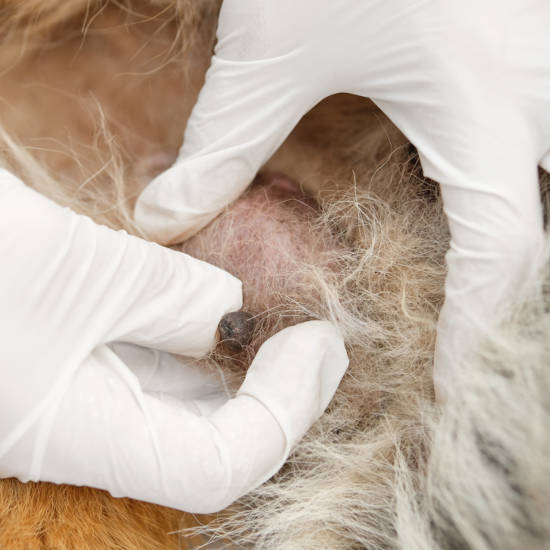
These tumors may vary in size and shape. They may also appear as a singular lump or multiple lumps along the same side.
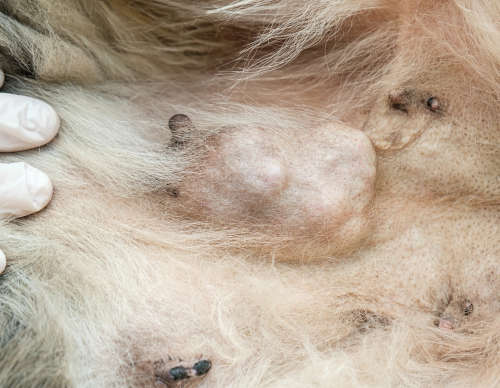
Benign vs malignant mammary tumors
Mammary tumors in dogs are benign about half the time and malignant about half the time. The most common types include benign adenomas, malignant carcinomas, and adenocarcinomas. The difference in types just depends on the tissue it arises from. Dogs may have both benign and malignant tumors at the same time. The only way to tell what type of mammary tumor a dog has is with a biopsy.
- Benign mammary tumors in dogs are usually small, firm, and well-defined. You may notice a small lump while petting your dog’s belly, as showcased in our picture below:
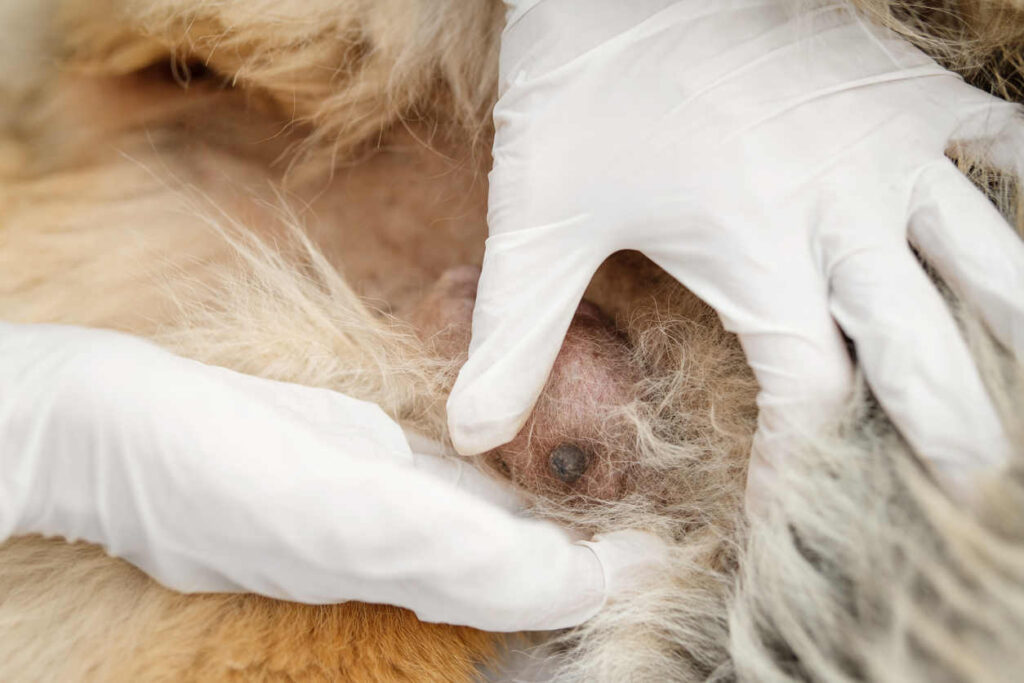
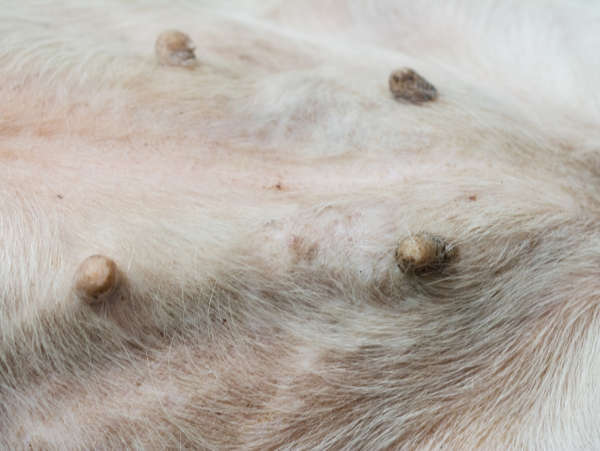
- Malignant mammary tumors may be small, large, a single lump, or multiple lumps. They often have bumpy edges and are tightly fixed to the skin or underlying tissue, as shown below:
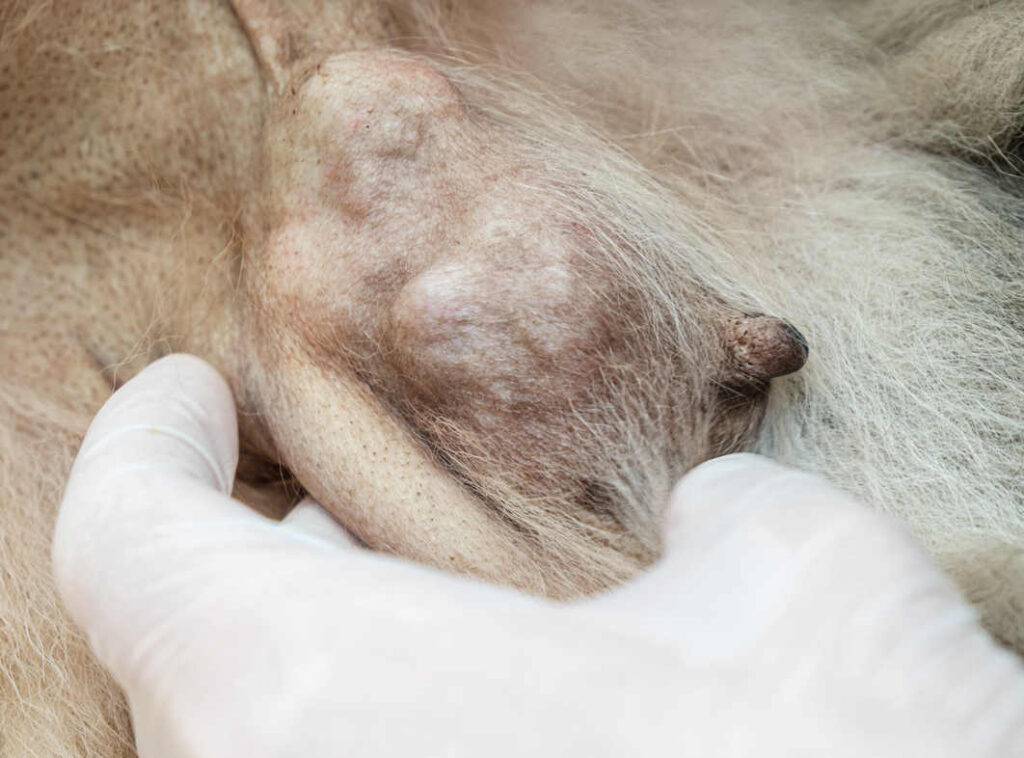
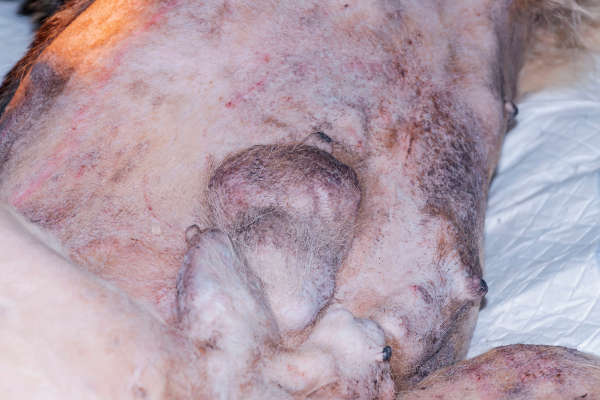
Symptoms often seen with mammary tumors in dogs
Most of the time, dogs with mammary tumors are going to be feeling fine. They will eat and drink normally and have a normal activity level. The first sign that owners note is a lump on their belly. Occasionally, the groomer or even the vet will find the lump on a routine exam.
Mammary tumors can be small and singular, or large and multiple. They may be easily moveable or tightly adhered to the body wall. There may be a little discharge from the nipple that’s associated with the affected gland.
The lumps may become ulcerated or even rupture. This may create bleeding or oozing sores on your dog’s belly, as shown on the picture below. You can learn more by reading our article: Dog Mammary Tumor Ruptures.
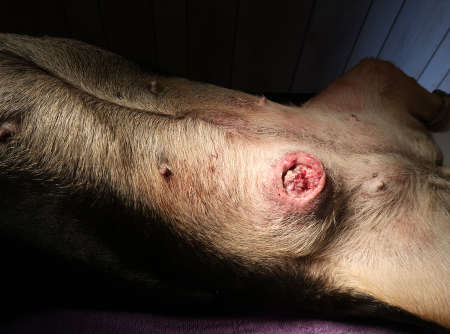
In cases of malignant mammary cancer, where the cancer has spread to other areas of the body, you may see enlarged regional lymph nodes, weight loss, vomiting, not wanting to eat, and difficulty breathing.
What’s the life expectancy of a dog with mammary tumors?
Here are key things to know about recovery and life expectancy:
- For benign tumors or malignant ones that haven’t yet spread, removal (without reoccurrence) is often curative. Benign tumors can be easily removed and NOT negatively affect life expectancy.
- Dogs with benign tumors (or malignant ones that haven’t spread) and are completely resected are most often cured without further treatment.
- Dogs with malignant tumors may live as little as one month or as long as one year or more without treatment. About half of all dog mammary tumors are malignant.
- Half of malignant tumors reoccur or spread to other organs. This leads to illness and a life expectancy of up to 1-2 years.
- Early detection and treatment will provide the best outcome. The smaller the tumor is, the more likely it will all be removed and the less chance it has of recurring and spreading.
Learn more about Life Expectancy & Survival Rate for Dogs with Mammary Tumors.
Caring for a dog with mammary tumors
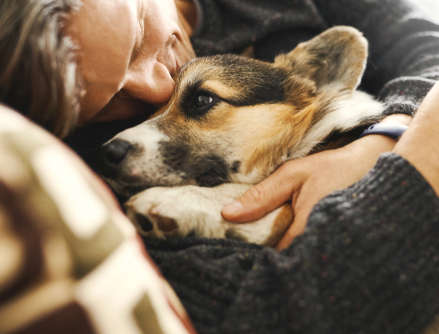
Mammary tumors require veterinary treatment, but that doesn’t mean you can’t make your dog more comfortable at home.
Step 1: Monitor
Intact females may develop temporary lumps in their mammary glands as a normal part of their cycle. These lumps, called mammary hyperplasia, will come and go two or three times a year or however often they come into heat. However, if you just noticed a new lump in or around your dog’s mammary glands, you’re better off having it checked by your vet.
Step 2: Rest and Relaxation
The treatment for mammary tumors, both benign and malignant, is removal. If your pup has multiple tumors affecting more than one mammary gland, this will be quite a surgery. Set up a cozy spot for them to rest and recuperate.
Step 3: Maintain a Healthy Weight
This speaks more for the prevention of mammary tumors, but obesity in puppyhood has been linked to an increased incidence of mammary tumors later on. So, be sure to keep your female puppy healthy and active by feeding them a high-quality diet meant for their age and lifestyle.
Step 4: Keep Them Clean
For dogs with ulcerated or bleeding tumors, you may put a light bandage over them to keep them clean and prevent your dog from licking them too much and causing more problems until you can see the vet.
Veterinarian treatment
If you notice a new lump or bump on your dog’s belly, your next stop should be to see your veterinarian.
Diagnosis
Your vet will start with a thorough exam, including when you found the lump and whether or not it’s grown. They’ll also be interested in other signs, such as weight loss, appetite, vomiting, etc. The next step is to take a sample of the tumor using a fine needle aspirate or biopsy. This will give your vet an idea of the cells that are making up the tumor.
From there, bloodwork, x-rays, or ultrasounds may be used to determine if the tumor has spread to other areas of the body. If not, it’s time to plan the treatment.
If you can, bringing a urine sample can help streamline the process. Your vet might want to do a urinalysis to check if other organs are affected, which could indicate that the tumor has spread.
Treatment & surgery
For nearly every mammary tumor, surgical removal will be the treatment of choice.

Tumor removal requires a large area to be resected and may involve removing multiple glands. For benign tumors or malignant ones that haven’t yet spread, removal is often curative.
However, there is a chance for reoccurrence. For tumors that have already spread, you’re looking at a discussion about quality of life and whether or not surgery is the right option. Consultation with a veterinary oncologist may be recommended. However, there is currently not a great chemotherapy or radiation protocol for mammary cancer.
Dogs may also get anti-inflammatory medications to help control certain types of mammary tumors. Spaying at the time of tumor removal may also be encouraged to help further prevent future tumors from forming.
The cost of treating dog mammary tumors is going to range depending on how many glands have to be removed and whether or not a spay or chemotherapy is done as well. Look to pay $500 or more for a single mammary tumor removal and upwards of $2,000 for multiple removals.
Read our article about the costs of removing mammary tumors in dogs.
Recovery after surgery
Most dogs will go home the day after mammary tumor surgery. Vets will like to keep them overnight to make sure bleeding and pain are controlled. Expect them to have a monster of an incision, especially if multiple mammary glands were removed. You’ll want to keep a close eye on that incision to check for swelling, redness, discharge, or odor.
You’ll also want to keep your dog quiet so they won’t rip any stitches out by running and jumping. Some dogs may also need an E-collar or soft cover to keep from over-licking or chewing on the incision. Antibiotics and pain medications will also be prescribed.
For pups with malignant tumors, consultation with a veterinary oncologist may be recommended to determine if chemotherapy or radiation should be pursued. Dogs with malignant tumors should also be kept on the lookout for new tumors to pop up in other mammary glands.
FAQ
How much does it cost to remove these tumors?
The cost to surgically remove dog mammary tumors is going to vary depending on the number and size of tumors. Small, singular tumors may be removed for as little as $500, while larger, multiple tumors may cost $2,000 or more.
How long can a dog live with mammary tumors? Are mammary tumors fatal in dogs?
The life expectancy for a dog with mammary tumors is going to depend on the type of tumor, the degree of spread, and any treatment. Benign tumors can be easily removed and do not affect life expectancy. Dogs with malignant tumors may live one month or one year, or more without treatment, while surgical removal without reoccurrence might be curative. Other dogs will have reoccurrence and even spread to other organs within 1-2 years. Learn more: Life Expectancy & Survival Rate for Dogs with Mammary Tumors.
Can I naturally shrink my dog’s mammary tumor?
There have been some natural or holistic treatments for mammary cancer touted. However, before trying any of these treatments, speak to your veterinarian to determine if your dog’s specific diagnosis, meaning tumor type and stage, may benefit from these types of treatment.
How often are dog mammary tumors cancerous?
Dog mammary tumors are malignant, or cancerous about 50% of the time and benign, or noncancerous about 50% of the time.
Do mammary tumors hurt dogs?
Mammary tumors can be uncomfortable or even painful, depending on the size. Large tumors can put pressure on the abdomen when a dog lies on their stomach. Malignant tumors can also ulcerate or rupture, which would feel similar to having an open wound on the belly.
Do mammary tumors rupture?
Some malignant mammary tumors in dogs may ulcerate or rupture, creating an open wound on a dog’s belly, as seen on the picture below. A ruptured mammary tumor can cause pain, inflammation, and infection, and can also lead to the spread of cancer cells to other parts of the body. Therefore, it is important to have tumors in your dog evaluated by a veterinarian as soon as possible to determine the right treatments. Learn more: Dog Mammary Tumor Rupture: A Vet’s Advice
Read more:
 Life Expectancy & Survival Rate for Dogs with Mammary Tumors - Key insights: For benign tumors or malignant ones that haven’t yet spread, removal (without reoccurrence) is often curative. Benign tumors… [...]
Life Expectancy & Survival Rate for Dogs with Mammary Tumors - Key insights: For benign tumors or malignant ones that haven’t yet spread, removal (without reoccurrence) is often curative. Benign tumors… [...]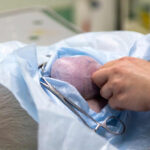 Cost of Removing Dog Mammary Tumors [By Surgery Type and Location] - ✔️Article written by a veterinarian, and reviewed by Dr. Whittenburg, Pet Hospital Director. Mammary tumors in female dogs are extremely common. So… [...]
Cost of Removing Dog Mammary Tumors [By Surgery Type and Location] - ✔️Article written by a veterinarian, and reviewed by Dr. Whittenburg, Pet Hospital Director. Mammary tumors in female dogs are extremely common. So… [...]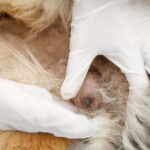 Rupture of a Dog Mammary Tumor: FAQ With a Veterinarian - Since dog mammary tumors make up more than 40% of all diagnosed tumors in dogs, it’s something that we deal… [...]
Rupture of a Dog Mammary Tumor: FAQ With a Veterinarian - Since dog mammary tumors make up more than 40% of all diagnosed tumors in dogs, it’s something that we deal… [...]Disclaimer: This website's content is not a substitute for veterinary care. Always consult with your veterinarian for healthcare decisions. Read More.


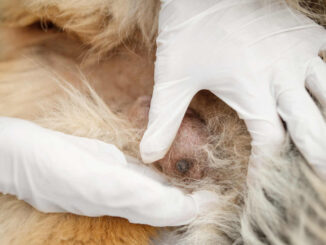


Be the first to comment